

Vol. 40 (Number 27) Year 2019. Page 1
ZAENCHKOVSKI, Artur E. 1 & KIRILLOVA, Elena A. 2
Received: 23/01/2019 • Approved: 11/07/2019 • Published 05/08/2019
2. Literature review and problem statement
ABSTRACT: Clusters are widely used as a tool to stimulate region innovation development. However, there are still no methods by which to evaluate the influence of clusters on region innovation development. And without an objective assessment, it is impossible to conclude whether the cluster policy gives competitive advantages and whether the financing of clusters from the Federal budget is justified. In investigation the analysis of foreign cluster experience scores in the United States and Europe. The regulatory framework related to Russian clusters was studied, and the applicability of foreign methods for assessing Russian clusters was analyzed. This article presents the methodology of measuring clusters impact on the region innovate development, which base on the following indicators: measure of comparison of cluster economic development and region ones, indicators the volume of domestic expenditures on research and development, input of cluster into the region economy, indicators is inventive activity coefficient and analysis of the main sources of funding. Methodology of evaluation of the cluster contribution to the innovative development of the region, supplemented by the author, was used to analyze the results of 27 innovative territorial clusters (ITC) work in 22 Russian regions. |
RESUMEN: Los clústeres se utilizan ampliamente como una herramienta para estimular el desarrollo de la innovación regional, sin embargo, todavía no existen métodos para evaluar su influencia en el desarrollo de la innovación regional y sin una evaluación objetiva, es imposible concluir si la política de conglomerados brinda ventajas competitivas y si la financiación de los conglomerados con cargo al presupuesto federal está justificada. En la investigación se estudió el marco regulatorio relacionado con los clústeres rusos y se analizó la aplicabilidad de los métodos extranjeros para evaluar los conglomerados rusos. El artículo presenta la metodología para medir el impacto de los conglomerados en el desarrollo innovador de la región, basada en los siguientes indicadores: medida de comparación del desarrollo económico de los conglomerados y los de la región, indicadores del volumen del gasto interno en investigación y desarrollo, aportes del conglomerado en la economía de la región, coeficientes de actividad inventiva y análisis de las principales fuentes de financiación. La metodología de evaluación de la contribución del clúster al desarrollo innovador de la región, complementada por el autor, se utilizó para analizar los resultados del trabajo de 27 clústeres territoriales innovadores (ITC) en 22 regiones rusas. |
Nowadays in the world modern economy conditions the effective country development can be possible only on innovative base and with opening national economy for new competitors and connections. To achieve this goal it is needed to use the innovative potential of regions, building the rational system of innovation management and development its organizational support. Moreover, innovative regions are more resistant to crisis phenomena. The consequences of the crisis, increasing competition, strengthening the role of modernization have led to increased attention to the use of clusters as proven development tools is shown in Sharko, Andrusenko (2017) and Vertakova, Plotnikov ( 2016). The development of industrial clusters, often spanning several related industries, catalyzes the economic growth of individual enterprises and regions to achieve a common synergistic effect as noticed in Feldman (2014) and Delgado, Porter, Stern (2014). It is also noted in Lee (2018) that the company, being part of the cluster, shows higher performance of its work.
Cluster`s approach for the regional development is very popular among developed countries. Danish, Finnish, Norwegian and Swedish industry is fully covered by clustering. For example, Finland, whose economic policy is based on clustering, has leading positions in the world competitiveness rating during the 2000s (The Global Competitiveness Report, 2017). Clustering structures in Germany (chemistry and mechanical engineering) and in France (food and cosmetics production) are successfully functioning. The active process of clustering formation is formed in Southeast Asia and China. In Singapore, in particular, in the field of petrochemistry, in Japan - automotive industry. Today in China there are more than 60 special cluster zones, in which there are about 30 thousand firms with the staff of 3,5 million employees and sales of approximately $ 200 billion a year. The results of innovation systems study made in 2006 by Regional Innovation Scoreboard in Europe showed a positive relationship between the innovative region development and the presence of successful clusters. In this regard, there is a growing interest in the problem of cluster formation and analysis of their impact on the innovative region development in Russia.
In the Russian Federation, according to different estimations, about 400 clusters have already been formed or are at the different stages of formation. According to the «Long-term social and economic development concepts of the Russian Federation for the period up to 2020», approved by the Russian Government one of the main direction of Russian Federation development is to increase the global competitiveness of the regional economy by using innovative technologies that will be formed on the basis of advanced development centers, including clusters (Strategy, 2011).
These facts emphasize the role of clusters in innovative development of the countries. In this context cluster means flexible network of production and technological cooperation of closely localized enterprises and scientific organizations which develop and implement the innovations and produce the same or related products and ensure together good competitive position at the domestic and foreign markets for the country industry and economy.
But there is quite small number of methods for cluster assessment in the terms of innovation region development and most of them are not adapted for Russian practice. In this regard, in order to improve the efficiency of the use of resources (including funds of state budgets of different levels) spent on the "clustering" economy, it is necessary to select and adapt the existing methods for assessment clusters impact on the innovative potential of the region, for making timely decisions on the management of the region and the development of the cluster.
That’s why this problem is becoming increasingly important for the theory of clusters growth and regional development.
The popularity of clusters development and the need to estimate the results of their activity determined the existence of a great amount of methods for their assessment. The literature of last century is very rich in coefficients, indicators, indixes, etc. which are used for measuring phenomena of clustering.
From qualitative methods we can distinguish: the method of expert assessments, the method of life cycles, synergistic effect measurement model, etc. In general, the main drawbacks of all qualitative methods is their subjective and approximate nature, as well as the lack of the ability to assess and analyze quantitative information and relevant indicators in the dynamics. Among quantitative methods in foreign practice most common methods are those based on regional inter-sectoral balance model (Boosting Innovation: the cluster approach., 1999). But in Russia such statistics data doesn`t collect.
European Cluster Observatory describes clusters measuring methodology based on such aspects as overall size, specialisation, productivity and dynamism, but there isn`t indicators reflecting the level of innovative development (European Cluster Panorama, 2016). Porter’s methodology of competitive advantages (Delgado, Porter, Stern, 2014) defines the different advantages of forming the innovative regional clusters for its individual participating enterprises based on the regional aspect. This methodology is applicable for the regions which are having the clusters for a long time and they are properly formed. Thus, for the Russian economy this methodology is little acceptable because of small number of export-oriented clusters and not all of them are sufficiently formed. Mercure, Pollitt, Chewpreecha, etc. (2015) assesses the innovation cluster influence on the growth rate of region GDP using Keynes multiplier coefficient. Fritsch, Slavtchev (2010) suggests using regional costs of R&D and resulting from high R&D intensity of the local private sector as well as knowledge from local public research institutions. Acs, Anselin, Varga (2002) prove necessity using patent statistic data for measuring innovation process of the territory.
Fedorov, Bendersky, Belevtsev, Epanechnikov (2008) proposed the method based on clusters functioning indicators calculation separately for small businesses included in the cluster (susceptibility to innovation, profitability and number of jobs created), as well as for the cluster as a whole (transparency of commercial activities, the presence of social groups that work on the basis of principles of self-regulation, as well as forms of trust between cluster members). At the same time, this method does not provide indicators for assessing cluster impact on the region economy as a whole and its innovative subsystem. Monastyrny (2006) considering the innovation cluster as a subsystem of the regional innovation system, offers an integral characteristic and structure of the innovation cluster model, based on the construction of innovation cluster interaction coefficients matrix.
It is also necessary to note the disconnection of the estimation methods of regional innovation potential and the estimation methods of clusters. Between these sets of methods there is no interconnection or indicators reflecting their interaction. This aspect of the clusters development is just started to be studied in Russia and abroad. Both Lindquist’s model (2009) and Kutseno’s method (2012), adopted for the Russian practice, consider the interconnection of clusters and innovations dealing with other closely connected factors. The paper (Lu, Ruan, Reve, 2016) presents an assessment of the life cycle stage impact in industrial cluster on the performance of regions and related industries.
In spite of active development of cluster policy on the theoretical level, in Russia practice this policy is not properly described and structured fragmentally and populist mostly. In Russian Statistics Committee’s books (Science and innovation, 2017) there are no indicators describing clusters work, this fact makes it difficult to collect relevant information for their comparison and timely assessment. Sukhorukov (2014) notes difficulties in assessing due to the lack of statistic data, which leads to the need to use expert assessments in most cases. Current assessment of different aspects of the scientific and innovation development of the Russian Federation is more completely reflected in Higher School of Economics books (Innovation indicators, 2017). Though such assessment is not always timely and comparable as the books are published not regularly and the analytical reports contain different aggregate indicators from report to report.
We propose the method of assessment clusters impact on the region innovation potential, which enables real-time diagnostic of its potential for timely decision making on management and development of the region and the cluster.
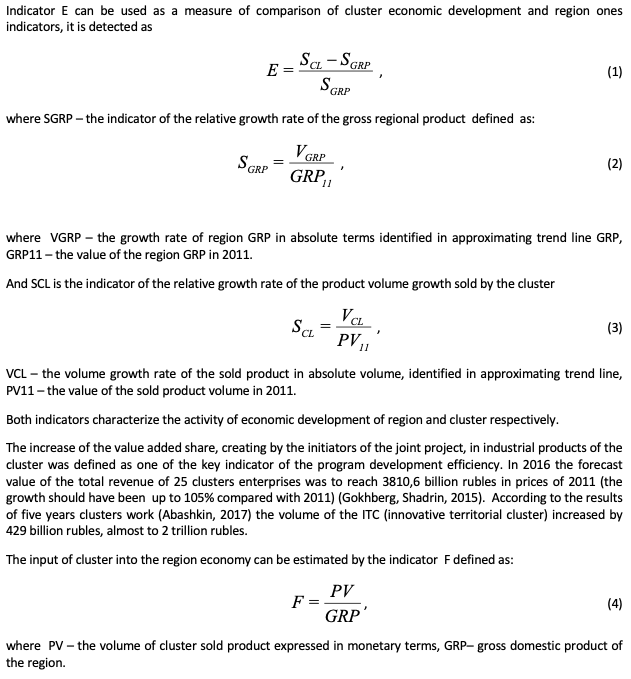
One of the clusters efficiency indicators is inventive activity coefficient defined as a number of domestic applications for a patent applied in Russia per 10 thousand people. This indicator stands out as a target within the framework of the Russian innovative development strategy for the period up to 2020.
For qualitative assessment of the connection between inventive activity coefficient and ITC economic activity it is possible to use Spearman's rank-order correlation coefficient Кс applied to samples Scl and Kia, where Kia is an average value of a coefficient of inventive activity for 2011-2016.
However, the appropriate financial support is required for the implementation of a large-scale innovative research and development projects. To estimate this support it is necessary to consider a retrospective analysis of investments dynamics and their structure (to assess the shares of budgetary and private investments). Here it is reasonable to use Spearman’s rank-order correlation coefficient estimating the connection between the level of the investments in region and the efficiency of ITC work.
The proposed methodology was used to analyze the results of 27 innovative territorial clusters (ITC) work in 22 Russian regions (Pilot programs, 2011).
As it is seen from the box plot in figure 1, the average value and the median of sold product volume in the cluster (corresponding volumes of colored rectangles) are higher than the relevant growth of the GRP in the region as a whole. This fact indicates a more rapid, in relative values, development of cluster than the development of region as a whole, where the cluster is located.
Figure 1
The comparison of the average relevant growth of regional GRP
(green colour) and sold product value of cluster (blue colour)

Developed by the author on (Abashkin, 2017)
However, considering each cluster separately, it can be noted the significant exceeding of the average values as well as clusters, the dynamic of which is lower than GRP of the region where they are located.
The maximum value of economic development activity is demonstrated in the cluster of pharmaceutics, biotechnologies and biomedicine located in Kaluga region and specialized in providing the high-tech medical care in the treatment of cancer. This fact is proved by the world practice of clusters functioning. Thus, according to (Temouri, 2012) in 2005-2007 the best growth rates were demonstrated by Oslo Cancer Center, specialized in the similar field. Udmurdsky machine building cluster has minimum values in terms of total revenue.
Figure 2 shows the distribution of indicator E values among the groups of similar clusters.
The analysis shows that the most stably developing clusters are those which activities are related to information technology (group 6). Clusters from this group show the growth rate which exceeds the regional growth rate 1,8 times on average. Clusters connected with biomedicine and pharmaceutics as well as clusters deals with the nuclear and radiation technologies show good results.
On the other hand, clusters connected with the aircraft and spacecraft manufacturing and shipbuilding demonstrate the worst indicators. The Consortium «Scientific, educational and production cluster «Ulyanovsk-Avia» has the worst growth rate. It should be mentioned that this fact is also proved by the global practice of the clusters development (Temouri, 2012), in 2005-2007 Tucson cluster (USA) connected with aircraft manufacturing had the worst growth rate.
Other clusters groups are characterized by rather a large spectrum of indicators including clusters with high and low activities.
Figure 2
Clusters development dynamics distribution
among the similar groups of industrial sectors
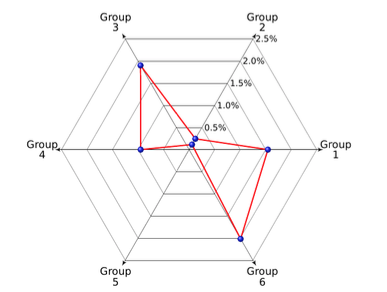
Developed by the author on (Abashkin, 2017)
Groups: 1 – nuclear and radiation technologies;
2 – aircraft and spacecraft manufacturing, shipbuilding;
3 – pharmaceutics, biotechnologies and medical industry;
4 – new materials;
5 – chemistry and petrochemistry;
6 – information technologies and electronics
-----
Figure 3 Shows the dynamics of average cluster contribution in the region where it is located.
Figure 3
Dynamics of average cluster contribution share in the GRP of
region (in percent, abscissa axis) by years (coordinate axis)
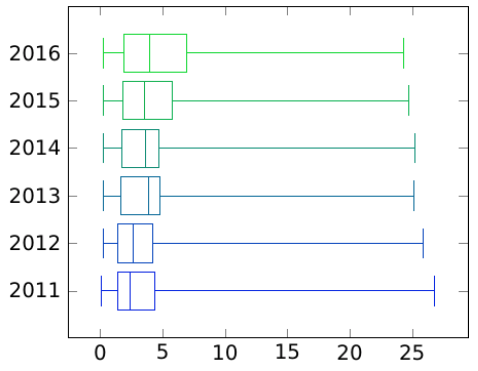
Developed by the author on (Abashkin, 2017)
Graphic in figure 3 shows the growth of clusters contribution into the economic indicators of the region, however, this dynamics is rather slow.
As it can be seen from the presented data, the median value of the product volume of cluster in GRP of region is about 2%, while half of all clusters occupies from 1,5 to 4 % in the GRP of the region. Abnormally high value of F is typical for Consortium «Scientific, educational and production cluster «Ulyanovsk-Avia» only, which includes the core enterprises of the region. The decrease of its role in the GRP is connected with the diversification of Ulyanovsk region economy including «Nuclear innovative cluster of Demitrovgrad» which has rather an active development and showed twice growth rate as high as the region’s overall growth.
The value less than 1% is typical for Moscow and Moscow region clusters, which is mostly connected with high values of GRP for this region and not with production volume of the cluster.
The analysis of dynamics shows that the median indicator in 2011-2016 was growing slowly increasing from 2,1% in 2011 to 2,5% in 2016.
As figure 4 shows, in regions, where ITCs (innovation territorial clusters) are located (marked in red in the figure 4), the coefficient of inventive activity is higher. It is also necessary to note, that its relative growth rate in regions with clusters is increasing faster compared with other regions, which is seen according to dots of ITC regions separated from the total mass of the regions in two last figures (white dots in the figure).
Figure 4
Dynamics of the coefficient rate of inventive activity/GRP
of the region per capita made according to
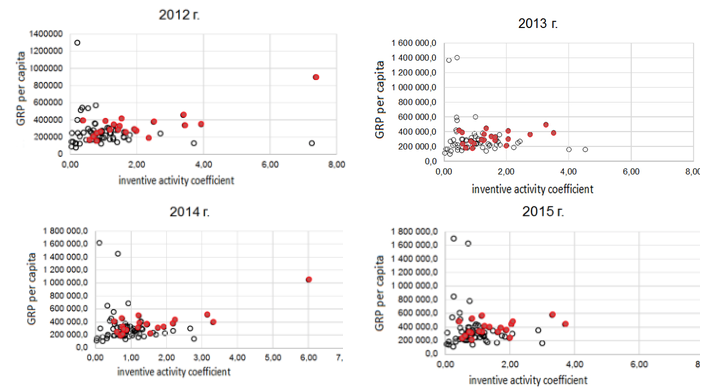
State statistics, 2016, Science and innovation, 2017
As the results of analysis show development of ITC impacts inventive activity growth in the region directly. The interconnection between inventive activity indicators and ITC economic indicators is rather complicated as intellectual property objects realization in industrial production is rather long process. On the level of significance p=0,1 the calculation of Spearman's rank-order correlation coefficient for relationship assessment between inventive activity coefficient and ITC economic activity show the statistically significant value Kc=0,28 proving a direct, though not very strong, existence of relationship between ITC efficiency and inventive activity of the region coefficient.
Figure 5 shows the distribution of investments average values into fixed capital per capita (without the budgetary funds) in 2012-2016. The whiskers correspond to the maximum and minimum values, the box borders correspond to 25% and 75% percentiles. The median value for all Russian Federation subjects is 57 thousand rubles, while in regions with ITC it is 73,8 thousand rubles.
Figure 5
Distribution of investments in the fixed capital per capita (without budgetary funds)
in regions with ITC (category2, abscissa axis) and in all Russian subjects
(category 1, abscissa axis)
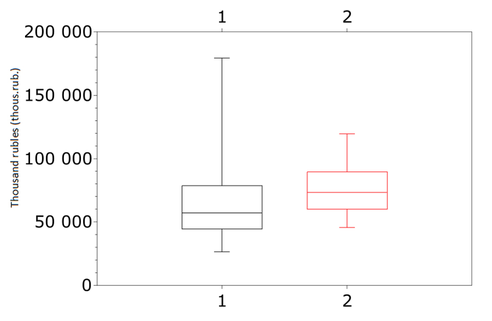
Developed by the author on (Abashkin, 2017)
As it is seen from the presented data, regions with ITC are characterized by higher median level of investments than Russian regions on average. 75% regions with ITC have investment level exceeding the median level of Russian Federation. Thus, the presence of ITC increases the investment attractiveness of region.
On the level of significance p=0,1 of Spearman's rank-order correlation coefficient between the investment value into the fixed capital (without the budgetary funds) and ITC economic activity shows rather weak positive connection (Кс=0,22). Thus, the level of non-government investments into region has a positive impact on the economic growth rate of ITC.
According to the report of ITC work for 5 years (Abashkin, 2017) the investments in their development from budgetary sources were amounted 98 billion rubles. At the same time, for every budget ruble, clusters managed to attract over 3.5 rubles of third-party investments. In total, 360 billion rubles were received in addition to budget investments. Over 109 billion rubles of them is the share of the Kamsky innovation territorial production cluster (Tatarstan), where they are working to create domestic industrial robots of the third generation as well.
Russian clusters financing analysis shows that innovative development is mainly supplied by budgetary finance sources. In the regions with ITC the external sources also prevail.
Thus, analysis of clusters development nowadays allows making the following conclusions:
1. The regions with ITC have the higher values of scientific and economic efficiency. In particular, the volume of GRP grows faster than the average one for the region, the number of high-performance workers is bigger, patent activity develops more actively and more sources of private investors are attracted. All these facts give the reason to assert that creating clusters stimulates the development of the region where it is located. So, Russian experience proves the global tendency to form clusters as highly efficient economic entities.
2. Authors justifies the use for assessment clusters impact on the region innovate development in the Russian practice such indicators as: measure of comparison of cluster economic development and region ones, indicators the volume of domestic expenditures on research and development, input of cluster into the region economy, indicators is inventive activity coefficient and analysis of the main sources of funding.
3. The analysis shows that in Russia not all clusters are developing with equal intensity. Some of them such as clusters of industrial groups (aircraft and spacecraft manufacturing, shipbuilding, chemistry and petrochemistry) show worse results than the average values.
4. Uneven development of clusters shows that principles being the basis of their creation are not very efficient. It requires the development of methodological and tools support for decision-making on the formation of various clusters in regions, as well as methodological and tools support for innovative clusters management.
5. Pilot innovative clusters, being a concentration of the most competitive enterprises, leading educational and scientific institutions, have an impact on almost all parameters of innovative development of regions.
6. The selection of clusters initiatives for regions should be made on the basis on region specific character, its production, human recourses potential and scientific and technical potential, the existing production and economic relations are also taken into account.
1. Abashkin, V. (2017) Cluster Policy: Reaching Global Competitiveness / V. Abashkin, S. Artemov, E. Islankina et al.; Ministry of Economic Development of the Russian Federation, RVC JSC, National Research University Higher School of Economics. – Moscow: HSE, 2017.
2. Acs Z.J., Anselin L., Varga A. (2002). Patents and innovation counts as measures of regional production of new knowledge. Research Policy, 31 (7), 1069-1085.
3. Boosting Innovation: the cluster approach. (1999). OECD Proceedings. Retrieved from https://www.hse.ru/mirror/pubs/share/212169923.
4. Delgado M., Porter M.E., Stern E. (2014) Clusters, convergence, and economic performance. Research Policy, 2014, Volume 43, Issue 10, 1785-1799.
5. Delgado M., Porter M.E., Stern E. (2014). Clusters, convergence, and economic performance. Research Policy, 43 (10), 1785-1799.
6. European Cluster Panorama. (2016). European Cluster Observatory report, 2016. 73 p. https://www.clustercollaboration.eu/sites/default/files/news_attachment/2016-12-01-clusterpanorama-2016.pdf.
7. Fedorov V. K., Bendersky G. P., Belevtsev A. M., Epanechnikov I. K. (2008). Features of the organization and prospects of development of innovation and production clusters. Innovation, 9. 96-98.
8. Feldman M.P. (2014). The character of innovative places: entrepreneurial strategy, economic development, and prosperity. Small Business Economics, 43(1), 9-20.
9. Fritsch M., Slavtchev V. (2010). How does industry specialization affect the efficiency of regional innovation systems? Annals of Regional Science, 45 (1), 87-108.
10. Gokhberg, L., Shadrin A. (2015). Pilot innovative clusters in the russian federation: implementation of development programs. National Research University Higher School of Economics. – Moscow: HSE, 2015.
11. Innovation indicators (2017) Innovation indicators[accessed 06-07-2018], Available online: https://www.hse.ru/primarydata/ii
12. Kutseno E. (2012) Influence of clusters on innovative activity of enterprises in the RF subjects: results of empirical research / E. Kutseno, 2012. M.: Publishing house of NRU HSE, pp. 495-504.
13. Lee Ch.-Y. (2018). Geographical clustering and firm growth: Differential growth performance among clustered firms. Research Policy, 47 (6), 1173-1184.
14. Lindqvist G. (2009) Disentangling Clusters: Agglomeration and Proximity Effects. Dissertation for the Degree of Doctor of Philosophy, Ph.D, Stockholm School of Economics, 2009
15. Lu, R., Ruan, M., Reve, T. (2016) Cluster and co-located cluster effects: An empirical study of six Chinese city regions / R. Lu, M. Ruan,T. Reve. Research Policy, 2016. № 45(10), pp. 1984-1995
16. Mercure J.-F., Pollitt H., Chewpreecha U., Salas P., Foley A. M., Holden P. B., Edwards N. R. (2015). Complexity, economic science and possible economic benefits of climate change mitigation policy. 2015. https://arxiv.org/pdf/1310.4403.pdf
17. Monastyrny E. A. (2006). Innovation cluster. Innovation, 2 (89). 38-43.
18. Pilot programs (2011) About the project of the list of pilot programs of development of innovative territorial clusters. Order of the President of the Russian Federation (Protocol of November 22, 2011 №PR-3484GS). [accessed 05-07-2018], Available online: http://economy.gov.ru/wps/wcm/connect/1a5dcd004bf64bef858d9d77bb90350d/doklad_proekt.pdf?MOD=AJPERES
19. Science and innovation (2017) Science and innovation [accessed 06-07-2018], Available online: http://www.gks.ru/wps/wcm/connect/rosstat_main/rosstat/ru/statistics/science_and_innovations/science/
20. Sharko V., Andrusenko N. (2017). Algorithm for estimating factors influencing intensification of production of industrial enterprises. Economic Annals-XXI, Volume 162 (Issue 11-12), 68-72.
21. State statistics (2016) The ratio of the highly productive workforce number per employed people [accessed 05-07-2018], Available online: https://www.fedstat.ru/indicator/51639
22. Strategy (2011) Strategy of Russian innovative development for the period up to 2020 [accessed 05-07-2018], Available online: http://minsvyaz.ru/common/upload/2227-pril.pdf
23. Sukhorukov A.V. (2014). To the question of evaluating the effectiveness of the innovative development strategy of the enterprise. Innovative economy, 2. 49 - 54.
24. Temouri, Y. (2012) “The cluster scoreboard: measuring the performance of local business clusters in the knowledge economy”, OECD Local Economic and Employment Development (LEED) Working Papers, 2012/13, OECD Publishing [accessed 05-07-2018], Available online: http://www.oecd.org/leed-forum/publications/WP%20-%20The%20Cluster%20Scoreboard.pdf
25. The Global Competitiveness Report 2017–2018 (2017) The Global Competitiveness Report 2017–2018 [accessed 06-07-2018], Available online: http://www3.weforum.org/docs/GCR2017-2018/05FullReport/TheGlobalCompetitivenessReport2017%E2%80%932018.pdf
26. Vertakova Y., Plotnikov V. (2016). Innovative and industrial development: Specifics of interrelation, Economic Annals-XXI, Volume 156 (Issue 1-2), 37-40.
The reported study was funded by RFBR according to the research project № 18-310-00222.
1. Ph.D. in Economics,associate Professor, Smolensk branch of the National Research University «MPEI» (Smolensk, Russian Federation), Email: kirillova.el.al@yandex.ru
2. Ph.D. in Economics,associate Professor, Smolensk branch of the National Research University «MPEI» (Smolensk, Russian Federation), Email: kirillova.el.al@yandex.ru